The Ministry of Defence (MOD) is pursuing “a deployable and persistent wide area ASW search capability” built around the new Type 92 Sloop – an uncrewed surface vessel – and the Type 93, a drone submarine, according to an industry notice.
The imagery associated with the programme suggests the aim is to monitor the GIUK (Greenland-Iceland-UK) gap.
The initiative, called Project CABOT, seeks to “accelerate the RN’s pivot to autonomy with a specific focus on Anti Submarine Warfare,” integrating “lean-crewed, remote-operated and autonomous airborne, surface and subsurface vehicle, sensor and node.”
According to the MOD, “Project CABOT is the plan to deliver remotely operated and autonomous ASW capabilities, allowing UK to pivot to vision of ‘Digitalisation of the North Atlantic’.”
One senior naval officer, speaking on condition of anonymity, emphasised the scale of ambition behind CABOT but cautioned that it remains an on-paper concept for now.
“This is where we want to go: a Navy with more ‘nodes’—more digital integration, more autonomous capability, more persistence at sea. Right now, we’re still in the early phases, but the goal is clear. Britain is now poised to be the premier power in the North Atlantic, leading the way in underwater surveillance and deterrence. If this works, we’ll have an unblinking eye on one of the most critical maritime corridors in the world—without tying up valuable crewed warships.”
“We’re talking about a shift in naval warfare. Traditionally, dominance at sea meant putting hulls in the water—ships, submarines, manned assets. Now, it’s about how many smart, interconnected platforms you can deploy. The more ‘nodes’ we have—autonomous ships, subs, and airborne sensors—the harder it is for any adversary to move unseen. This is the direction the Royal Navy is heading.”
This project builds on Project CHARYBDIS, previously delivered by the Submarine Delivery Agency (SDA) under the Defence Innovation Unit’s “ASW Spearhead” programme. Recent “technological and digital breakthroughs achieved by the (UK) ‘NATO ASW Barrier’ Smart Defence Initiative” have also helped pave the way for CABOT’s next steps.
According to a Pre-Procurement Notice published in the UK government’s Contracts Finder, the MOD is launching an early market engagement to “commence a conversation between the Royal Navy and Industry Partners on capability’s that will accelerate the RN’s pivot to autonomy”.
The notice clarifies that Project CABOT will proceed in two phases:
Phase 1 – ATLANTIC NET
Delivering “ASW as a service” through a Contractor Owned, Contractor Operated, Naval Oversight (COCONO) model. “Lean crewed, remotely operated or autonomous uncrewed systems, delivered by an industry mission partner,” will gather “acoustic data, triaged by AI/ML algorithms,” then transmit it to a “secure Remote Operations Centre (ROC) for analysis by RN staff.”
This setup aims to “significantly increase mass and persistence at sea whilst releasing traditional RN platforms for other tasking.”
Phase 2 – BASTION ATLANTIC
Shifting to a government-owned, government-operated (GOGO) model in which the Royal Navy “own and operate USVs (Type 92 Sloops) and UUVs (Type 93 Chariots).”
This phase also considers “a host of other sensors, to deliver mass and persistence in the North Atlantic,” as well as exploring “UK developed Underwater Battlespace Area Denial (UBAD) capabilities.”
As part of CABOT’s broader heritage, the SDA has commissioned the Defence and Security Accelerator (DASA) to seek “innovative related technologies and sub-systems,” inviting submissions from across the Technology Readiness Level (TRL) spectrum.
The broader aim
The MOD emphasises that the objective is to “build a better understanding of current market capability and potential developments to inform decisions on how best to go ahead and deliver Project CHARYBDIS.”
This could include evaluating “opportunities for disruptive future capability,” determining “the required level of modularity for future systems,” and clarifying “choice of interfaces.”
Although this process does not yet commit the MOD to any specific development path, it highlights the Royal Navy’s drive toward scalable, autonomous anti-submarine warfare solutions.
When and indeed if fully implemented, Project CABOT aims to bolster the Royal Navy’s capacity to detect, track, and deter submarines across the North Atlantic, particularly around the vital GIUK gap.
By employing drone ships and submarines in tandem with advanced sensor networks and AI-driven analysis, the Royal Navy stands to enhance its maritime surveillance, free up crewed warships for other missions, and fulfil an evolving strategic requirement to protect sea lines of communication.


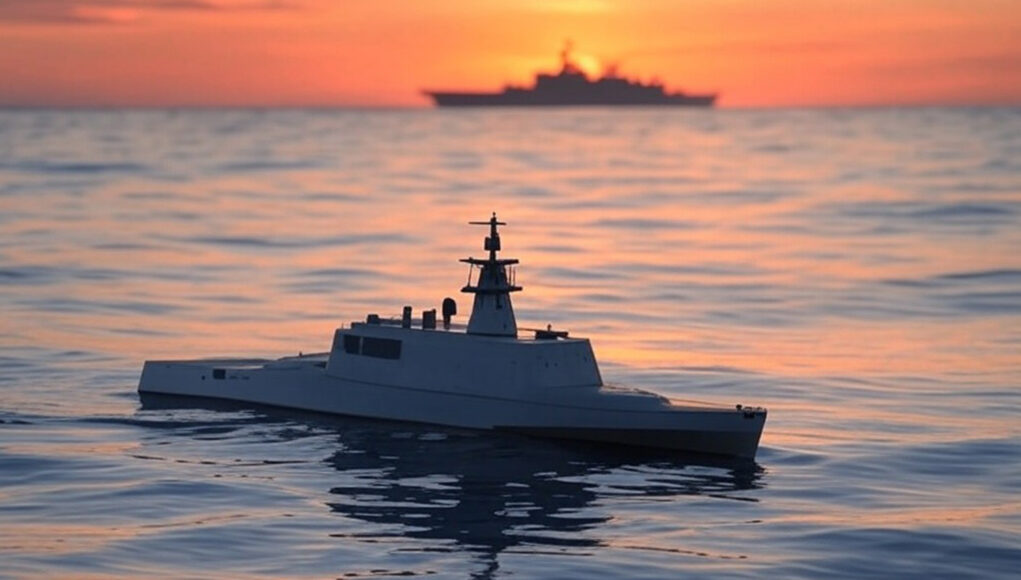
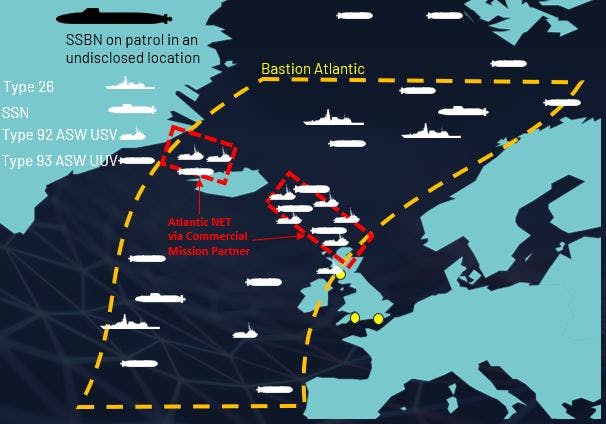


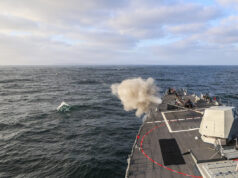
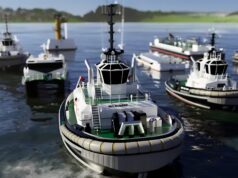
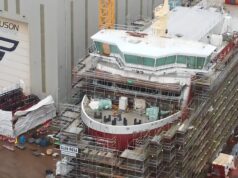
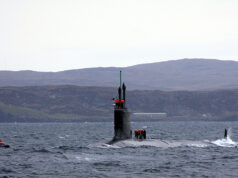
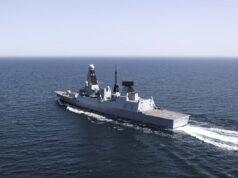

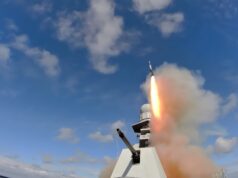
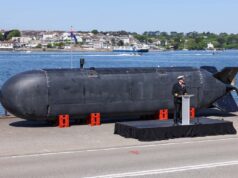
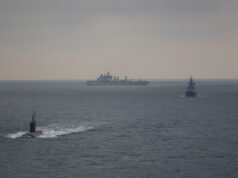
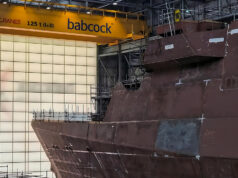

I can’t stand seeing computer generated images of loads of ships we don’t have we need ships and we are getting rid of them…..
I’ve often felt the same. It’s fantasy land given the realities of political decision making and financing of our armed forces. I’ve always taken the attitude of I’ll believe it when I see it.
It’s insane that RFA vessels have been used to monitor Russian ships traveling past the uk, due to lack of warships. Ok the Russian ships pose no realistic threat without a mass amount of support, but it’s optics and it just makes the uk look silly.
There is no money in the national purse due to the mess caused by the last goverment (e.g. billions spent proping up schools and hospitals because replacements weren’t ordered, money that didn’t need to be spent). However if there is i would like to see an investment into speeding up the build of the new ships, so we get back to close to 19 escorts, or even 10 active would be a big step up.
NOT ‘Jam tomorrow ” but “lots of jam in a decade or so”.
We need more hulls now!
Yes i was wondering if there is still a need for “real” ships of some sort and that haven’t veen built yet, to deploy and monitor these “drone” ships? Isn’t the T32 ship requirement part of all this?
*been
No, I’ve been discussing this in quite a lot of depth on other forums.
What the Navy seem to be looking (In the Type 92, the surface component) for is a vessel that can go out into the North Atlantic, carry a sonar towed array, and do that with as much availability as possible.
So a ship with a hullform optimised for maximum seakeeping, probably between 25-50m in length.
There’s a company called Acua Ocean in Plymouth who have been invited to previous industry days and have a concept for a SWATH (submerged hull catamaran) USV 26m long. They’ve made a 14m demonstrator craft already with a payload of 4 tonnes, which isn’t quite enough for a CAPTAS-1.
Acua Ocean’s SWATH is >6 tonnes payload, pending sea trials which commence shortly.
You still need something to integrate the multi-static sonar results, interpret and act. Raw sonar is very data heavy and I’m not sure that this could be handled through a satellite link without pre-processing. I believe that will push us towards having local integration vehicles. Could a P-8 handle it? Otherwise it might have to be a crewed surface vessel.
From reading the article, onboard AI and Machiine Learning will analyse the raw data before reporting its results to the nearest human for actioning. Only in those cases where it thinks it’s found something, the raw data may also broadcast back for human confirmation of its analysis.
Shouldn’t be too much of an issue; a handful of ships to cover the actioning of data and any control input to the drones.
Such ships could be done cheaply using existing commercial hulls, I’d imagine. They won’t be going into combat themselves so would only need basic defensive weapons.
Hopefully the unmanned vessels – both surface and subs – actually have some weapons on board as well, so that they can act (with human input, of course!) and not just monitor, requiring a manned ship or aircraft to take action.
Aren’t the Independent LCS looking for a role in life?
With LO satellite constellation like one web and starlink data transfer can be massively speeded up and their is tonnes of free bandwidth over the North Atlantic that no one is using.
Let’s not go with Starlink.
Decouple as much as possible from a) the US and b) that twat Musk!
Not a fan of LO satellites strategy, they need to be replaced roughly every 5 years or so. That’s alot of launches and replenishment and the materials can’t be recovered.
Well we’re going to be using OneWeb already as a GPS alternative and own a stake in it.
If the job is just monitoring fleets of drone ship then it’s more like the T31 will do it, the T31 is very much looking for a job to do. One will be deployed to the gulf at any one time. Previously there was thoughts another one would go to Singapore but that will no longer be happening after Pete Hegseth speech. T32 won’t be happening now. We will be bulking up the navy using these drones instead of new frigates which is probably a sensible approach as we won’t see new frigate for a decade abs what ever happens with Russia it will all be over in 10 years.
We probably will get 6 MRSS now and they will have their own defensive armament but we won’t be getting any T32.
Just because the US is throwing it’s teddy out the pram doesn’t mean we can’t stay enaged in East of Suez. We potentially have a lot to gain from partners in the region, regardless of what the US is doing.
We don’t have to confront China to stay engaged in the region, nor should we if the US won’t do us the same courtsey with Russia.
I agree east of Suez just not east of Diego Garcia. We can tilt to the pacific in a world where the US is involved in all aspects of European security but not after the Munich speech. We need to double down on our own region which is the Euro Atlantic and Middle East. Everything else has to go.
We can participate in industrial projects with Japan and we should do something with Australia if we can but that’s it. There are no resources for anything else.
We can’t square off against China anymore. It’s pretty clear the USA will be pulling up its pacific draw bridge soon anyway. Malaysia, Singapore and Brunei have all already sold out to China no need for us to be there.
Not quite everything. We need to be ready to protect the Falklands if anything happened – however unlikely. But other than that, yeah. Let the US handle it, since apparently they apparently do all the work anyway.
The Pete Hesgeth speech will have no long term effect. Most of these daft speeches are for US domestic consumption.
Is anyone else a little worried by the process to shift from commercial owned and operated to government owned and operated? Starting off commercial should give a faster route to operational status, at higher cost. However, we’ve seen with Peregrine that the budget then limits the size of the operation to nothing more than a test. In the case of Peregrine we reportedly run just two medium drones off one ship at the cost of £10m a year. At the end of the two-year contract we’ll own nothing and may well have trained nobody. The shift to government owned has to be factored into the original phase if it’s to work.
I believe it may become the same here. We won’t be able to afford a full-scale Atlantic NET, the GIUK gap is 700 miles wide, and at best the exercise will cover a smaller expensive test area. Without a solid plan starting on day one to bring this under government ownership and Navy control, we could end up with nothing at the end of it.
I think it’s a positive, lots of innovative industry ideas out there that don’t need uniformed personnel and civil servants slowing them down. These platforms are just sensors so they can easily be civilian.
Seems odd to me to make them just sensors?
We should give them some teeth. If a Russian ship is cutting cables in the Atlantic we’d need to respond quickly. Add a couple of torpedoes to the drones, set it up so that it needs a human input to launch them, and then we have an effective way of countering such threats without having to quickly mobilise MPAs or ships, which might not arrive in time to prevent damage from being done.
The teeth will come from the frigates, helicopters and P8’s monitoring the drones. Submarines are really easy to kill when you know where they are.
If we arm these drones they will cost a fortune and open up all sorts of problems.
The Atlantic is a big area, though. Will we have assets in proximity to be able to take any offensive action, should the drones find, say, a Russian ship engaging in hostile action? How far from said frigates would these drones be operating?
How quickly could we send out a P8 armed with either torpedoes or anti-ship missiles to attack it?
I think we’d need to have more P8s at the very least. And/or work really closely with Canada and their own P8s, in the case of anything in the North Atlantic/GIUK.
This all sounds a bit familiar and History has a habit of repeating itself, someone designs an affordable weapon that can be built in mass and immediately someone else decides to add extra capabilities / weapons till it’s unaffordable.
During the Cold war one of the RNs main tasks was ASW in the GIUK gap and in 70’s they started to think about the need to replace the 1950/60 designed Type 12’s. That resulted in the T22 but they were expensive and cheaper options were explored the main requirements were Sea keeping, Lean manning, decent endurance, a Helicopter deck, very limited self defence ability and most importantly able to Tow a VDS in the North Atlantic.
The result was the early very sparse incarnations of the T23 design, but they still thought it too expensive so a member of the RCNC was tasked to look at a cheaper alternative. David.K Brown had designed the Castle class OPV and it had all of the 1st 4 so the others were added.
Only problem was that when all the additions were added up it was nearly the same price as the T23.
I get the idea of Nodes and ROVs but how do you deal with Damage Control, maintenance or handling the VDS ? To me it would make more sense to identify suitable civilian OSV’s for surface Nodes and design a containerised VDS / Comms sytem to fit the work deck. RNVR comes to mind.
And spend the money saved on more Warships.
On the other hand the idea of sub surface USV nodes with bow and towed array sonar and possibly a Torpedo makes a hell of a lot of sense providing the comms are up to it.
So it’s Black autonomous Swans 🙂
Black CyberSwan?
That is kind of how I am reading it. Same hull different payloads. Some nodes, some TAS, some force protection maybe.
How long do we think it’ll be before someone raises the issue of Cabot’s links to slavery and the name gets changed?
The UK taking sole responsibility for the North Atlantic seems like a great idea. It’s an easy thing for us to offer Europe and North America as our big contribution. The US can bugger off to the pacific knowing we have their backs in the Atlantic. It’s something we are already very good at and it’s our own major security concern.
The T23’s are f**ked and won’t last much longer. Buying more frigates or submarines will take 10 years minimum. We can start knocking out these drones in a year or two and flooding the North Atlantic with them. This is the best way for us to spend any additional money we can get from the treasury near term on the navy. We can free up larger platforms for task force escort and land attack roles.
Slight correction: let’s not let the US know we have their backs in the Atlantic. We’ll have CANADA’s back in the Atlantic.
The US can jog on, as far as I’m concerned.
The West has gone completely nuts, stand down and broker Peace!
Surrendering or appeasement does not deliver lasting peace.
Tell that to Putin!
Putin could broker peace right now by calling his troops back home.
Do you know American entities own more of Ukrainian than Russia occupies?
At one time it was illegal for Ukraine to sell land to foreigners.
Changing that law was a condition of the West’s loan to the Kiev government.
But the government decided to go with the Russian condition free loan, so Barry Obama’s got rid of it.
Perhaps one day instead of speaking utter rubbish you might learn some facts!!!!!!!!!
Just out of interest, is anyone else not receiving email notifications about replies to their posts?
Keeping a tab open to periodically check if anyone has replied to something written is frustrating and an edge too far towards narcissism for me- so I don’t. Which means I miss responses that I’d have otherwise replied to. @George, is there a setting I need to change or something, it used to work…
Joe.
That has not worked for months. George is aware.
Yet another fantasy project that will come to nothing like the many that have come and gone over the years for the UK MOD. You need real hardwear that does what it says on the tin for a specific role. All this proposed kit still needs maintaining etc and that seldom comes cheap. the old saying ‘When Pigs Fly’ comes to mind.
No matter how good AI etc ever comes to be there should always be a HUMAN to make the final decision and someone needs to get their hands dirty keeping it all working and currently the youth just dont want to sign up defend the Freedom they enjoy provided by others.
There are better and more efficient solutions out there and if its kept simple it may actually deliver the info saught. The UK is a spent state.
I can’t help thinking that the Russians will just find a way to jam these UAV’s then sail up next to them and nick ’em.
In our dreams we are doing this, such lovely MoD dreams they are. But we all have to wake up!
How many similar looking pretty graphics have there been in the last few years about the future of drones, all with money spent and no output. To me it’s very clear that the west has not learnt from the Ukraine war and still focused on trying to make drones directly replace old assets.
The return of Sloops and Chariots!!!Boys Own stuff!!…..The MOD is now firmly in fantasy fleet waters….The horrific truth is the RN is a hollowed out crumbling shell short of escorts(current and future),aircraft,personnel,RFA assets,operational funding,a clear plan…..Dire days and all the pretty CGI will make no difference whatsoever..